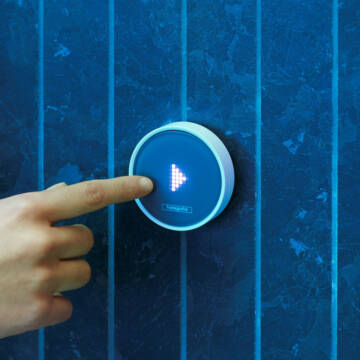3 ways drones are shaking up our way of looking at the world

The way we observe and experience the world has been shaken up by the emergence of drones, in both scientific and commercial perspectives. Learn about 3 ways in which drones will overthrow the world as we know.
The way we observe and experience the world has been shaken up by the emergence of drones, in both scientific and commercial perspectives. Learn about 3 ways in which drones will overthrow the world as we know.
Today, we already use them to track the evolutions of wildfires or measure the size of jellyfish population. In the future, through even more impressive evolutions, drones could for example ensure fully autonomous delivery systems. Or who doesn’t want a dusting drone that cleans all your indoor surfaces? One thing is certain, we stand at the tipping point of a world in which drones are an indispensable part of society.
Over the past 10 years, the drone market has experienced a tremendous growth. According to the Drone Market Report 2020, the global drone industry will grow from €18.5 billion in 2020 to over €35.3 billion in 2025 at a CAGR of 13.8%. For the growing commercial drone industry, investments facilitate the drones not only to become smaller, faster, smarter and safer, but also easier to control.
The progression to a drone filled world is already taking its first steps. As you have probably noticed, drones are getting more and more prevalent in both commercial and nonprofit industries. In the near future, its use will become even more extensive, but mostly exciting. The following examples are some of the many ways in which unmanned aircraft will revolutionize the way we get things done.
100% good harvest thanks to farmer drones
By 2050, UN forecasts the world population to rise to 9.7 billion by 2050. Due to this massive expansion of people to feed, the agricultural consumption has to rise with 69% between 2010 and 2050. A means to achieve this gigantic increase in food demand is through precision agriculture. This includes the way farmers manage crops to assure an efficient usage of resources such as water and nutrients, and to optimize productivity, quality, and profit yield.
Using drones, farmers can continuously monitor the condition of crops and livestock from the sky, allowing them to quickly identify problems which ground checks would not reveal. For example, a farmer may discover through time-lapse drone photography that part of his crop is not being properly irrigated, a prompt resolution to this problem will save us from a poor harvest.

Drones in agriculture will mainly be used for mapping/ surveying & cropdusting/ spraying. The first process, mapping or surveying, crops is fairly simple and will be used in the near future. Many of the newer agricultural drone models are equipped with flight planning software that allows the user to draw the area to cover. As the drone flies, it automatically takes photographs using onboard sensors and the built-in camera. As previously mentioned, rapid detection of potential issues will lead to better yields.
Drones used for spraying crops are much more advanced and precise in their task than traditional tractors. A more precise approach comes with a number of advantages. First of all, it helps to reduce costs and, in addition, it prevents the possible exposure of workers who would have had to spray the crops manually to pesticides.
The new flying police dog
There are a multitude of reasons why drones can be useful for law enforcement purposes down the road. The most obvious ones are: surveying vast open areas, chasing suspects, traffic and flow management, event management and seizing illegal drones.
In dangerous cases like negotiating hostage situations, pursuing armed suspects and investigating bomb threats, drones could allow police to safely navigate through potentially dangerous scenarios while ensuring the safety of their officers. The number of victims should consequently decrease.
In the aftermath of hurricanes, tornadoes and other natural disasters, it can be extremely challenging to get ground troops to the affected areas. Getting manned aircraft into dangerous areas without endangering the pilots can be equally difficult. For this reason the future well-equipped and improved drones will be used to survey disaster sites and identify areas and people in need of help.
Instant automated deliveries
Intelligent drones are expected to change the delivery industry for good. Through the use of drones for the delivery of goods the world might become even more interconnected. Unmanned aircrafts can access the hard-to-reach places on earth, even the most remote and rural areas will become instantly accessible.
For every different kind of transportation there will be a new sort of drone. A new wave of airplane-sized autonomous delivery vehicles can transport hundreds of pounds over hundreds of miles. They are called cargo drones. With their speed, eco-friendliness, and ability they will change the freight industry completely.
Impulse purchases could skyrocket over the next few years. Following the promises of various retail and transport giants, which claim that soon deliveries could be carried out on the same day or even within 30 minutes.
Most importantly, if other modes of transportation are unviable, drones might become lifesavers. The use of drones reduces the difficulties associated with the delivery of relief and medical supplies in disasters and emergency situations.
Let's end with some food for thought, what would you think of a drones flying over your backyard when you are peacefully sunbathing. Or if drones were frequently flying over the local playground. Unmanned aircraft can be used as a third eye in the sky and this can have both positive and negative consequences. For example, during the last holiday season there were rumors of using drones to check whether citizens were complying with social distancing measures. Now that we are on the eve of the large-scale use of drones, it is important that we think about how to regulate them and what do you think of all the exciting new possibilities compared to the negative consequences that this could have for your privacy.
Sources
Precision agriculture in 2021: The future of farming is using drones and sensors for efficient mapping and spraying. (2021, February 8). Business Insider. https://www.businessinsider.co...
Shivakumar, F. (2019, June 10). Giant cargo drones will deliver packages farther and faster. The Verge. https://www.theverge.com/2019/...
Project, D. (2019, December 25). Here’s how drone delivery will change the face of global logistics. Medium. https://medium.com/@dronair_pr...
Rice, S. (2019, October 7). 10 Ways That Police Use Drones To Protect And Serve. Forbes. https://www.forbes.com/sites/s...
Latest insights & stories

A Global Movement: The World Unites in a Pink Pledge for Clean and Sustainable Water
5,000 participants. 32 countries. €30,000 funds raised. And that's just the beginning.
Picture this: One step that sends ripples across the globe, transforming lives and creating waves of change. You might wonder, how can such a simple action for most of us have such a profound impact?

Sustainability and circularity in construction
Join us in transforming the future of construction, creating buildings that not only stand the test of time but also contribute to a healthier planet!

RainTunes: Shower scenarios for the soul
Light, hearing, smell, and touch: Together with experts, we have developed sensuous scenarios that turn showering into an individual experience. Whether you want to prepare for the day ahead or relax after working out. Whether you want to refresh after a day’s work or unwind at the end of the evening: RainTunes surprises with multisensory experiences.*
*Currently available only in Germany and Austria.